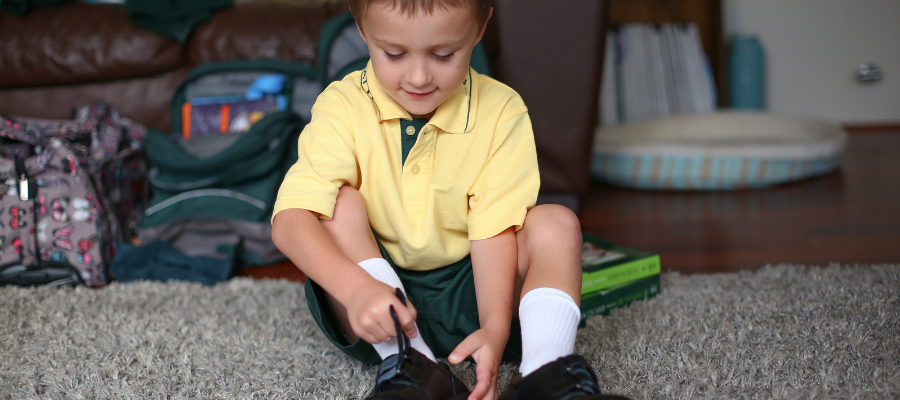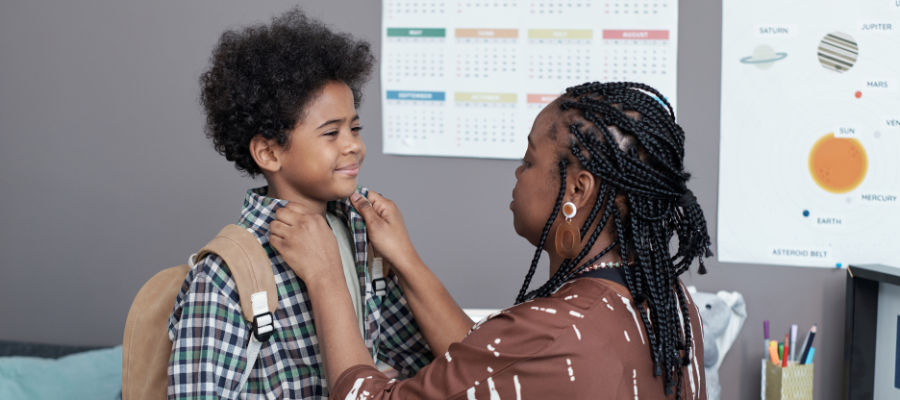Navigating PDA and School Avoidance: How to Support Children and Families

Getting to school each day can be difficult for many children, but it can be especially challenging for kids living with Pathological Demand Avoidance (PDA) and their families.
Children with PDA often experience the school environment as overwhelmingly demanding, leading to significant stress and anxiety that can make attending school an immense challenge. This daily struggle, known as ‘school can’t’, adds pressure and uncertainty at home, impacting the wellbeing of the entire family.
In this article, we explore tools and strategies for parents and educators to help children with PDA feel seen, safe and supported throughout their schooling journey.
Understanding the ‘school can’t’ struggle
A look at the stats
‘School can’t’, often referred to as school refusal or avoidance, is a complex issue affecting an estimated 1-5% of Australian school children. Research shows that children with autism (ASD) and ADHD are at higher risk of school avoidance, adding to the complexity of their school experience.
A recent report by Aspect Australia estimates that autistic children are three to four times more likely to experience ‘school can’t’ than their neurotypical peers, with the challenge accounting for up to 57% of absences among autistic students.
PDA is a profile on the autism spectrum characterised by extreme resistance to everyday demands and expectations. Considering this resistance, it’s not surprising that a PDA Society report revealed that 70% of children with PDA are either not enrolled in school or regularly struggle to attend.
School avoidance driving factors
School is a busy place that can feel overwhelmingly demanding for neurodivergent children. The structured nature of the school day, with its fixed schedules, social expectations and sensory stimuli, can be particularly challenging for children living with PDA.
According to Thambirajah et al. (2008), “School refusal occurs when stress exceeds support, risks outweigh resilience and factors promoting non-attendance overcome those encouraging attendance.”
Stuck in a constant battle between fight, flight and freeze, kids with PDA can experience unrelenting anxiety that drives an obsessive need to control situations and resist demands, leading to meltdowns, avoidance and sometimes extreme behaviour. While the day-to-day triggers for avoiding school may change, the underlying reason remains the same—anxiety.
Several anxiety-related factors can contribute to ‘school can’t’ including:
- Separation anxiety: Leaving a parent or carer can be deeply unsettling for children who are already feeling anxious.
- Social anxiety: Entering a crowded environment where interaction is expected can feel overwhelming.
- Academic challenges: Undiagnosed dyslexia, dysgraphia and dyscalculia can make learning really difficult.
- Routine and relevance: Following routines and engaging in activities that don’t interest kids can be taxing.
- Sensory differences: Wearing a school uniform and adjusting to noise, bright lights and different smells can heighten anxiety.
- Bullying: Kids with PDA don’t always reach out for help when they’re being bullied, which can negatively impact their sense of safety at school.
When one or more of these factors are present, children with PDA may use distraction, defiance or even aggression to avoid going to school and participating in activities that magnify their anxiety.
The biggest challenge with PDA is that conventional strategies and tools rarely help, leaving parents, carers and educators feeling unsure of how best to support children. The key to understanding and supporting kids with PDA is recognising that their behaviours stem from a mismatch between their environment and their needs, not willful disobedience.
The key to understanding and supporting kids with PDA is recognising that their behaviours stem from a mismatch between their environment and their needs, not willful disobedience.
Fortunately, more resources and strategies are becoming available to better support these children, including specialised training for educators, tailored therapy options and support groups for families.

At home: Navigating the school struggle
In the morning
Mornings can be especially challenging for children with PDA. Everyday tasks like getting dressed, brushing teeth and packing bags can be overwhelming due to demand avoidance.
Add hidden demands to the mix—like sitting at the table to eat breakfast—and the morning routine can quickly become too difficult to manage.
Think of the elastic band analogy.
If your child’s elastic band is already stretched tight, they’re likely operating close to maximum capacity. This means they’ll have little tolerance or ability to handle demands and stressors. Even small, everyday tasks can become overwhelming and add to their anxiety. If the elastic band is loose, they’ll have more capacity and flexibility to handle demands and manage their anxiety.
So, how do you keep the band loose?
It’s a delicate balancing act. Think about the environmental triggers that might stretch their band on any given day. Kids who are hungry, aren’t hydrated enough or didn’t sleep well can carry over anxiety from the previous day. If you think this is happening, it can help to soften your language and reduce the number of questions you ask.
Keep in mind that when tolerance is already low, language-based demands—like asking them to put on shoes—can exacerbate their anxiety and make it extremely difficult for them to get out the door.
As the time to leave for school approaches, anxiety can build and peak to the point where their brain shuts down. This can lead to verbal outbursts, aggression, crying and clinging, which is distressing for the child and heart-wrenching for parents and carers.
Arriving at school is another major hurdle for kids with PDA. As they transition from the car to the classroom they’ll feel less and less in control, which can be quite distressing. Separating from a parent or carer, their safe space, makes this part of the day even harder. Having a trusted adult meet your child at the school gate can help to ease this transition.
In the afternoon
Afternoons can be equally turbulent. As the school day comes to an end, children with PDA often find it harder to tolerate noise, conversation and planned activities. This is because their internal struggle and dysregulation, which may have been invisible at school, can become more visible in a safe space—often in the car on the way home. When this happens, they might try to take control of the situation and lash out at any suggestions.
In my clinical experience, PDA can present differently in boys and girls. When it comes to afternoons, boys tend to be very motor-driven (full of energy), while girls tend to express their pent-up distress verbally. In either case, their need to regain a sense of control can make afternoons challenging for the entire family.
Tips for parents
For some parents, the path to effective support begins with a mindset shift. Keep in mind that your child’s avoidance of school is an act of desperation driven by escalating anxiety about the day ahead.
Whether you’re trying a new strategy at home or working with a care team, the goal is to help your child feel safe and regulated while building their skills. The best way to support this is with a low-demand approach, rather than a no-demand approach.
The goal is to help your child feel safe and regulated while building their skills.
Here are some strategies you can try to reduce anxiety and support your child on their schooling journey:
- Reframe language: Gently reframe language to be less direct and more conversational. Instead of “I need you to” try “I wonder if we can”. It can also help to minimise the amount of language used. This reduces the perception of demands and helps lower anxiety.
- Offer choices: Where possible, give your child the option to say no or be flexible. For example, consider gamifying getting dressed using indirect language like “I wonder who’ll get dressed first?”.
- Reduce sensory overwhelm: Identify potential sensory stressors around your home and consider how to minimise them during the morning and afternoon routine. This might involve turning down the lights, reducing noise and offering food choices. An occupational therapist can support you with a sensory assessment and creating a sensory diet.
- Increase familiarity: Help your child become more familiar with tasks and the school environment. This familiarity can not only reduce their anxiety but can also increase their sense of control—something we all value when we feel unsafe. Visiting the school during off-hours or meeting teachers in a low-stress setting can be beneficial.
- Stay flexible: Be willing to adjust your expectations and collaborate with your child to find what works best. If a particular strategy isn’t working, don’t be afraid to try something new.
- Be mindful: Highly anxious PDA kids can say hurtful things, so try not to take this personally. In these moments, it can be helpful to reframe your thinking and remind yourself that their language stems from their flight or fight response being activated.
For additional support and strategies, consider reading The Low Demand Parenting Book and register for our PDA-aware parenting webinar.

At school: Spotting the signs and supporting students
In the classroom
Children with PDA can present differently in school than they do at home, and these differences can be quite pronounced. Some children visibly unravel in the school environment, showing signs of stress and anxiety through their behaviours and actions. They might struggle to comply with demands, become easily frustrated or display outbursts of anger. These externalised behaviours can make it pretty clear that they’re having a hard time coping with the school environment.
On the other hand, some kids with PDA can mask their feelings during school hours, appearing to manage well on the surface while experiencing significant internal distress. These children often keep their anxiety hidden (masked) throughout the school day, only to fall apart once they are in the safety and familiarity of their home environment.
Masking can make it hard for educators to fully understand the child’s behaviour and know how best to support them in the learning environment.
PDA in boys
Boys with PDA are more likely to show external signs of distress, including restlessness, impulsivity and visible anger. They might have difficulty sitting still, following instructions or interacting calmly with their peers and teachers. This can significantly reduce their ability to solve problems, pay attention and learn because they’re so focused on managing their anxiety and distress.
Educators might misinterpret their behaviour as willful defiance or lack of discipline, rather than recognising it as a response to overwhelming demands and anxiety. Boys with PDA are often seen as disruptive and often mistakenly diagnosed with Oppositional Defiance Disorder (ODD)—a condition that shares similarities with the PDA profile.
PDA in girls
Girls with PDA tend to hide their distress, appearing quiet and withdrawn at school. They may sit silently in class, avoid participation and try to make themselves invisible to avoid drawing attention. While changes in body language or facial expressions might give the impression of concentration or compliance, they are often struggling internally, which reduces their capacity to learn.
Girls with PDA often seem shy or disengaged and stay quiet instead of asking for help. This makes it harder for teachers to notice their struggles, as their quiet behaviour draws less attention than the disruptive behaviours seen in some boys.
Tips for educators
Understanding how PDA presents differently in boys and girls is an essential first step for educators to provide effective support. By recognising the signs and implementing tailored strategies, both parents and educators can help children to feel safe and supported.
Here are some strategies you can try to help students with PDA navigate their time at school:
- Build trust: Establish a positive relationship with the child before implementing strategies. Trust is the foundation for successful interventions.
- Maximise engagement: Integrate their interests into the curriculum to increase engagement. For example, if a student loves sports, incorporate sports-related problems into maths lessons where possible.
- Offer choices: Provide choices to lessen anxiety and give kids with PDA a sense of control. Think about what the non-negotiables are and offer flexibility around the rest.
- Consider structured activities: Lunchtime can be stressful for kids with PDA, so consider introducing interest-based activities and social groups.
- Utilise sensory supports: Offer tools such as noise-cancelling headphones, fidget toys or weighted blankets to help manage sensory sensitivities. It’s important to tailor sensory support to students individually, as not all kids have the same needs.
- Offer quiet spaces: Provide access to quiet areas where the child can retreat to when feeling overwhelmed.
- Collaborate with support teams: Work with parents, carers and allied health professionals to troubleshoot, problem solve and create a tailored support plan. Collaboration is key to fostering a safe environment for kids with PDA.
- Explore funded support: Consider funding or special education services that can assist with support and equipment.
Most importantly, remember that behaviour in the classroom can be a sign of internal distress rather than intentional defiance. If you would like to learn more about supporting students with PDA, please register for our PDA-aware teaching webinar.
Moving ahead together
Nurturing children with PDA in the school environment calls for understanding, patience and adaptability from parents, carers and educators. By making changes at home and implementing tailored strategies in the classroom, we can help children feel seen, safe and capable.
Are you a parent or carer navigating Pathological Demand Avoidance? Finding what works and making changes isn’t an easy thing to do. My advice is to be kind to yourself and create a support network that includes PDA-aware allied health professionals and other families walking the same path.

Dr Nicole Carvill is an accomplished child psychologist, researcher, presenter and PhD graduate who dedicates her time to helping children and families thrive. A mother of two and caregiver by nature, she approaches therapeutic support through the lens of a psychologist with the heart of a parent.
